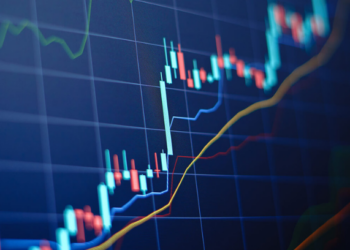United States
The S&P 500 Index and the tech-heavy Nasdaq Composite Index both gained ground, snapping a seven-week losing streak. The S&P 500 advanced in every sector, with consumer discretionary and energy stocks leading while the healthcare industry lagged. This cross-sector strength reflected the hope that inflationary pressures were nearing their peak.
Consumer spending increased more than expected in April, while inflation had peaked, potentially supporting economic growth in the second quarter due to rising inflation fears. According to the Commerce Department on Friday, consumer spending, which accounts for more than two-thirds of all economic activity in the United States, increased 0.9 % last month. As previously reported, the March data was revised higher, with outlays racing at 1.4 % rather than 1.1 %.
The U.S. Treasury yields slipped on Friday as fears over a federal reserve‘s plans to aggressively hike interest rates appeared to ease and a critical inflation reading showed a rise in prices. As a result, the benchmark 10-year Treasury note yield moved lower by 1 basis point to 2.743%. Municipal bonds rallied, with traders attributing this strength to investors seeking out attractive relative valuations. The decline in Treasury yields and a light new issuance calendar ahead of the holiday weekend may have also aided the rebound.
S&P Global latest ‘flash’ PMI (Purchasing Managers Index) data showed a slower expansion in business activity across the U.S. private sector in May. Manufacturers and service providers reported softer output increases amid rising inflationary pressures, worsening supplier delivery times, and weaker demand growth. Manufacturing output and new orders were strong, but the survey found that input costs and output charges rose significantly. The flash PMI reading for the services sector was 53.5, down from 55.6 in the previous month.
Europe
European stocks rose significantly on Friday after lower expectations of bullish U.S. data and large interest rate hikes, giving them their best weekly performance since mid-March. The European index gained 1.5 % for the third consecutive session, bringing its weekly gains to three per cent. The German index gained 1.6 %, closing at its highest level in over a month.
A Wall Street rally fuelled by retail and technological revenues, as well as positive consumer spending data for April, alleviated some of the market’s concerns about a slowdown in economic growth. Inflation in the United States has also been low over the last month, according to data.
The yield on core eurozone bonds fluctuated but ended slightly higher. Yields initially rose after European Central Bank (ECB) President Christine Lagarde suggested that positive rates could be achieved by the end of the year. Yields fell slightly as eurozone PMI data came in weaker than expected. U.K. gilt yields broadly tracked core market yields, while yields on peripheral eurozone bonds fell.
A purchasing managers’ survey found that Eurozone business activity in the private sector held up better than expected in May, thanks to strong demand for services, particularly from households. The S&P Global Flash Eurozone Composite PMI, a monthly indicator of the services and manufacturing industries, fell to 54.9 in June from 55.8 the previous month. Firm input cost inflation has slowed for the second month in a row.
In an interview published on Wednesday, Bank of England Chief Economist Huw Pill stated that more interest rate hikes are likely, but that the central bank is concerned that too many will keep the economy in recession. A UK purchasing managers’ survey showed that business activity came close to stagnating in May. The S&P Global/CIPS Flash PMI Composite Output Index was 51.8 in May—a 15-month low that was down from 58.2 in April.
japan
The Japanese stock market began the week on a high note, only to be dragged down by three consecutive session losses. However, a late rally on Friday not only helped to end the losing streak but also saw Japanese equities close in positive territory. The Nikkei 225 finished 0.16 % higher in local currency, while the broader TOPIX gained 0.53 %. The yield on Japan’s 10-year government bond fell, while the yen rose against the U.S. dollar.
Meanwhile, an increase in coronavirus cases in Beijing has sparked fears of an economic slowdown due to supply chain concerns. Concerns about tightening global financial conditions and their impact on economic growth weighed similarly on Japanese sentiment. Further losses in the U.S. technology sector have also harmed investor confidence.
However, Japanese equities rallied on Friday after Wall Street closed sharply higher overnight. Investors are in a buying mood due to optimistic retail earnings forecasts and fading concerns about the Federal Reserve’s overly aggressive interest rate hikes. However, as the Nikkei 225 approached 27,000, investors sought to book profits, limiting market gains.
China
The Chinese markets weakened after concerns about the slowing growth by the government’s zero-tolerance approach to the coronavirus. The Shanghai Composite index eased by 0.5% and the blue-chip CSI 300 Index which consists of the largest listed companies dropped 1.9% which further saw data reporting profits in China’s industrial firms fell at their fastest pace in two years in April affecting sentiment.
The yields in China’s 10-year government bonds lowered to 2.756% from 2.836% within the week due to China’s policy over covid. The Yuan was weak to CNY 6.71 for 6.68 per dollar. There would be expectations of capital outflows from China due to a yuan depreciation, making Chinese assets less attractive as U.S. interest rate hikes have an adversely affect them.
Since March, major Chinese has been under lockdown. They have gradually relaxed the restrictions, allowing businesses to reopen and residents to leave their homes. On the other hand, Beijing increased quarantine efforts to reduce the ongoing outbreak.
Shanghai took more gradual steps on Friday towards lifting its COVID-19 lockdown, the financial hub and the capital have been hot spots, with a harsh two-month lockdown to arrest a coronavirus spike in Shanghai and tight movement restrictions to stamp out a small but stubborn outbreak.
China’s economy is stumbling back to life, but data show only a slow and partial recovery, with businesses ranging from retailers to chipmakers warning of slow sales as domestic consumers tighten their purse strings.
Home sales in China have been tumbling for months as potential buyers worry about weakened developers being unable to complete promised projects and grow anxious about the country’s economic direction. Last month’s COVID lockdowns in Shanghai and other areas turned April into a rout for many property companies.
Debt-laden property developers in China continued their efforts to recover from a liquidity crisis. According to Reuters, Evergrande Group is considering repaying its offshore public bondholders with cash instalments and equity in two of its Hong Kong-listed subsidiaries.
Weekly Market Indices
|
| Weekly Index |
| YTD Index |
| ||
| Index | Local Currency | Sterling Pound | Local Currency | Sterling Pound | ||
| UK |
|
|
|
| ||
| FTSE 100 Index | 2.68% | 2.68% | 4.52% | 4.52% | ||
| U.S. |
|
|
|
| ||
| S&P 500 Index | 6.62% | 5.38% | -12.21% | -5.74% | ||
| EU |
|
|
|
| ||
| Euro Stoxx 50 | 2.53% | 3.19% | -10.73% | -9.37% | ||
| Asia |
|
|
|
| ||
| Nikkei 225 Index | -0.23% | -0.34% | -7.34% | -9.87% | ||
| Hang Seng Index | 0.30% | -0.88% | -10.76% | -4.83% | ||
| MSCI Emerging Markets Index | 0.33% | -0.26% | -12.10% | -8.25% | ||
About Author
How can we help you?
If you would like to speak to one of our advisers, please get in touch today.




